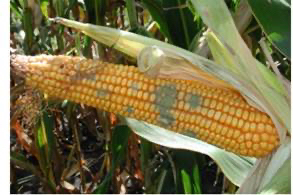
Crop Protection Network
Aflatoxin fungus.By JAKE LYSKAWA
Capital News Service
LANSING – A toxin produced by a fungus in corn will increase over the next few years because of global warming, according to a Michigan State University study.
From 2031-40, over 89.5% of the counties in 15 states will experience a rise in aflatoxin levels, according to the study in the Environmental Research Letters.
Corn is mega-business in Michigan where the value of the 2021 crop of corn used for grain topped $1.85 billion, U.S. Department of Agriculture statistics show.
That year, farmers in three counties planted at least 100,000 acres of corn: Sanilac (108,000), Lenawee (107,000) and Huron (100,000). Overall, farmers in the state planted 2.35 million acres, according to the department.
Aflatoxin is a toxin produced by two fungi that can cause cancer. They typically grow near food crops and enter the corn through pollen tubes or through damage caused by insects.
Aflatoxins are the most prevalent natural liver carcinogen. Chronic levels of exposure can hinder child growth and nutrition, the study said.
The primary culprit? Climate change.
The two fungi that produce aflatoxins grow more readily in warm, dry climates. That’s why they’re most prevalent in Southern corn crops, the study said.
As climate change worsens and air becomes warmer and dryer, more corn crops will become contaminated with aflatoxins, it said. That will likely decrease the amount of healthy, clean corn available for those who rely on it for dietary and economic purposes.
How we collectively manage the problem over the coming years is a primary concern for agricultural scientists like David Hennessy, a production economist at Iowa State University who worked on the study while he was at Michigan State University.
“Part of the reason for writing this paper is to alert corn growers in the Midwest that this problem may be on the way to you,” Hennessy said.
The Midwest is likely to see the greatest rise in aflatoxin accumulation because its current climate is less dry and less warm than in the Southern U.S. The hotter the air in the Midwest becomes, the more likely these fungi are to grow there.
Another problem presented by the increase in aflatoxins is how it impacts animals.
If livestock like cows and pigs eat contaminated corn, farm production will decrease and less animal products will be available for consumption, Hennessy said.
It’s a problem issue primarily in the U.S. because the type of corn most prone to aflatoxin contamination is fed to animals here, Hennessy said.
“It’s a problem because animals fed corn that is afflicted with aflatoxins won’t perform very well,” Hennessy said. “They’ll have reduced growth rates and so on. So there are limits on how much aflatoxin can be in corn fed to hogs, cattle and poultry.”
Aflatoxins are regulated for both human and animal by the Food and Drug Administration, according to the study. Not many corn producers now experience great loss due to aflatoxin contamination, especially in the Midwestern Corn Belt and Northern states.
If the study’s projection is accurate, the risk of contamination will increase so significantly that clean corn may be in short supply. That could quickly become a global issue, as the U.S. Corn Belt is a major supplier of the crop across the world, Hennessy said.
For people in other countries who rely heavily on corn for food, that could adversely impact their way of life.
Food security would decrease as the Corn Belt sees an uptick in aflatoxin production, causing a ripple effect in some national economies, Hennessy said.
MSU student and climate activist Sarah Bill noted that an increased demand for clean corn could change how its market operates.
“If there’s only so much [corn] that doesn’t have aflatoxin in it, then people are going to buy it all and the price might increase,” Bill said.
Avoiding the myriad of issues that result from aflatoxin accumulation is critical over the coming years, Hennessy said. He and his colleagues identified a few mitigation strategies.
“There are papers in the literature that demonstrated, nearly two decades ago, that irrigated cropland was less prone to aflatoxin incursions than non-irrigated,” Hennessy said. “Where the aflatoxin is currently most prevalent is in the U.S. South and along the Great Plains, in particular Texas. But not when you go further north, because of the Ogallala aquifer.
Northern states draw from an aquifer to provide the water, and that protects, in part because unlike rainfall, the water is available when needed. The stress that allows for [insect] incursions isn’t as likely to occur when the crop is irrigated.”
These prevention measures are great for farmers and scientists, but what can the average person do to help?
Much of the solutions require a large-scale effort. Scientists and researchers like Hennessy continue to work toward an answer every day.
But people like Bill say we can reduce the many negative effects of climate change, including aflatoxin production.
“I try to consume less energy because I know Americans consume about as much as anyone in any other country,” Bill said. “We always have air conditioning on and stuff like that, so I try to keep it off. No food waste, I’m trying to be better about that.”
Jake Lyskawa writes for Great Lakes Echo.